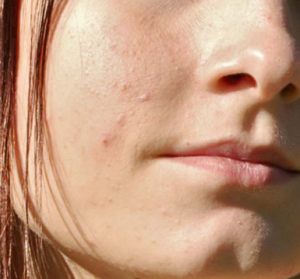 In a forthcoming study in the Journal of Psychiatric Research, a Cosmetic Dermatologist and a Professor of Psychiatry at Georgetown University did a controlled, randomized study on 74 patients with major depression. Half of them received Botox in the forehead muscles and the other half received saline injections.
In a forthcoming study in the Journal of Psychiatric Research, a Cosmetic Dermatologist and a Professor of Psychiatry at Georgetown University did a controlled, randomized study on 74 patients with major depression. Half of them received Botox in the forehead muscles and the other half received saline injections.
6 weeks following the injections, 52% of those receiving Botox showed relief from depression while only 15% of those who received Saline did.
If confirmed in larger studies, Botox may end up being an important anti depression drug
Botox an anti depression drug?
Sun Safety this Spring Break!
 With spring break around the corner, many of our patients will be traveling to warmer climates. We are getting lots of questions about sunscreen: what’s good, how much, when, etc? We hope these sunscreen facts help clear up any questions y…ou may have.
With spring break around the corner, many of our patients will be traveling to warmer climates. We are getting lots of questions about sunscreen: what’s good, how much, when, etc? We hope these sunscreen facts help clear up any questions y…ou may have.
SPF stands for Sun Protection Factor. SPF is determined by a mathematical equation which examines the amount of light needed to induce redness in sunscreen protected skin, divided by the amount of life in unprotected skin is the SPF
How do these numbers affect me? Sunscreen that is SPF 15 will delay the onset of a sunburn in a person who would otherwise burning in 10 minutes to burn in 150 minutes. This allows the person to be out in the sun protected for 15 times longer than they could otherwise.
Are the HIGH SPFs better? While no sunscreen offers 100% protection from UVA and UVB rays, higher SPF sunscreens may protect better against long-term skin damage and other exposure-related skin cancers.
Waterproof, is it worth it? Experts recommend using water-resistant sunscreen when possible and applying it approximately one hour prior to going outdoors.
What type of sunscreen is best for me? It depends. I know, sorry I couldn’t be more specific. It depends on what you are anticipating doing—are you playing sports? Swimming? Wearing sun-protective clothing? Lotions and moisturizers that already contain SPF are great to use for everyday activity, but if you are going to spend a lot of time outdoors, you will need beachwear-type sunscreen.
How much should I use? In order to get the full SPF from your sunscreen you should apply approximately 1 oz, a full shot glass, of sunscreen. Typically, the average person applies only a quarter of that!
Enjoy your vacation or staycation and for more sun safety tips please see our website: www.lakeviewderm.com.
Peanut consumption during pregnancy reduces the risk of peanut allergy in children
 A recent article in the JAMA Pediatrics (December 2013) shows that if a NON ALLERGIC pregnant woman eats peanuts or tree nuts at least 5 times weekly, her child has a much lesser chance to develop peanut or tree nut allergy than the child of a  non allergic mother who eats no nuts.
A recent article in the JAMA Pediatrics (December 2013) shows that if a NON ALLERGIC pregnant woman eats peanuts or tree nuts at least 5 times weekly, her child has a much lesser chance to develop peanut or tree nut allergy than the child of a  non allergic mother who eats no nuts.
This is not true if the child’s mother has allergies.
This study suggests that early exposure to an allergen increases tolerance to said allergen.
Indoor Tanning in white women on the Rise
Indoor tanning among white, non-Hispanic women is on the rise. In a survey of 2527 non-Hispanic white females age 14 to 18 years, 29% stated they were using tanning salons and 17% of them stated they were tanning frequently. In this age group, the frequency of tanning increased with age.
In a survey of 1857 non-Hispanic white females age 18 to 34 years, 25% stated they were using tanning, 16% of them frequently. However, in this age group, the prevalence and frequency of tanning decreased with age. Indoor tanning before age 35 increases non-melanoma skin cancer risk by up to 75%, and indoor tanning before age 25 increases the non-melanoma skin cancer risk up to 102%.
As to Melanoma skin cancer, the prevalence is increasing, especially in young non-Hispanic women. However, precise prevalence data are limited. It has been a few years since the World Health Organization has classified tanning as a class 1 carcinogen. Nevertheless, the majority of the populations are unaware of this, and the tanning industry is thriving to the tune of billions of dollars annually. Do not be fooled by the tanning industry's claims, because there is no such thing as a "safe tan". JAMA Internal Medicine August 13, 2013.
New treatment for severe facial and ocular Rosacea on the Horizon
 A recent study demonstrated that 46% of patients with Rosacea (including 4 with treatment resistant ocular rosacea) had Small Intestinal Bacterial Overgrowth (SIBO) as opposed to 23% in the general population. This condition was diagnosed by a simple breath test (Lactulose Breath test).
A recent study demonstrated that 46% of patients with Rosacea (including 4 with treatment resistant ocular rosacea) had Small Intestinal Bacterial Overgrowth (SIBO) as opposed to 23% in the general population. This condition was diagnosed by a simple breath test (Lactulose Breath test).
Rosacea patients were treated with an antibiotic (Rifaximin) which remains in the intestine and is not absorbed.
Complete resolution of symptoms occurred in all 4 patients with ocular rosacea as well 78% patients with facial rosacea.
The authors recommend a larger study of facial and ocular rosacea, chcking for SIBO and its treatment with Rifaximin, be done in a Dermatology Clinic.
(Journal of the American Academy of Dermatology, May 2013)
A bacteria typically found in our pores, may actually protect skin from acne
According to findings published in the Journal of Investigative Dermatology, certain strains of Propionibacterium acnes, a bacteria typically found in our pores, may actually protect skin from other strains of P. acnes that cause inflammation in the form of pimples.
A team from UCLA, Washington University in St. Louis and the Los Angeles Biomedical Research Institute collected samples of P. acnes from the noses of 101 people, about half of whom had acne. Researchers than sequenced the genomes of 66 of the more than 1,000 P. acnes strains identified, focusing their attention on genes unique to each strain.
The team discovered one strain of P. acnes that was common on healthy skin but rarely found on skin with acne. Two other strains of the bacteria, on the other hand, were typically found on the pimpled people but rarely on those with clear skin.
Researchers suspect the strain associated with clear skin may have a natural defense mechanism that destroys other, less desirable strains before they can cause inflammation.
“This P. acnes strain may protect the skin, much like yogurt’s live bacteria help defend the gut from harmful bugs,†said Huiying Li, the study’s lead author and an assistant professor of molecular and medical pharmacology at the David Geffin School of Medicine at UCLA.
Adapted from: “Good†Bacteria is Secret to Avoiding Acne by Gemma Tarlach in The Discovery Magazine
Odors from Human Skin Cells Can Be Used to Identify Melanoma
According to new research from the Monell Center and collaborating institutions, odors from human skin cells can be used to identify melanoma, the deadliest form of skin cancer. In addition to detecting a unique odor signature associated with melanoma cells, the researchers also demonstrated that a nanotechnology-based sensor could reliably differentiate melanoma cells from normal skin cells. The findings suggest that non-invasive odor analysis may be a valuable technique in the detection and early diagnosis of human melanoma.
Melanoma is a tumor affecting melanocytes, skin cells that produce the dark pigment that gives skin its color. The disease is responsible for approximately 75 percent of skin cancer deaths, with chances of survival directly related to how early the cancer is detected. Current detection methods most commonly rely on visual inspection of the skin, which is highly dependent on individual self-examination and clinical skill.
The current study took advantage of the fact that human skin produces numerous airborne chemical molecules known as volatile organic compounds, or VOCs, many of which are odorous. “There is a potential wealth of information waiting to be extracted from examination of VOCs associated with various diseases, including cancers, genetic disorders, and viral or bacterial infections,” notes George Preti, PhD, an organic chemist at Monell who is one of the paper’s senior authors.
“We are excited to see that the DNA-carbon nanotube vapor sensor concept has potential for use as a diagnostic. Our plan is to move forward with research into skin cancer and other diseases,” said A.T. Charlie Johnson, PhD, Professor of Physics at the University of Pennsylvania, who led the development of the olfactory sensor.
Together, the findings provide proof-of-concept regarding the potential of the two analytical techniques to identify and detect biomarkers that distinguish normal melanocytes from different melanoma cell types.
“This study demonstrates the usefulness of examining VOCs from diseases for rapid and noninvasive diagnostic purposes,” said Preti. “The methodology should also allow us to differentiate stages of the disease process.”
Current studies are focusing on analysis of VOCs from tumor sites of patients diagnosed with primary melanoma.
From: Monell Chemical Senses Center. “Odors from human skin cells can be used to identify melanoma.” ScienceDaily, 13 Jun. 2013. Web. 5 Jul. 2013.
Eczema More Prevalent in Smokers
While smoking has been known for some time to aggravate Asthma, a recent Israeli study of 10,298 adolescents (13-14 years old) has shown that Eczema and Allergic Rhinitis is also more prevalent in smokers than non-smokers.
However, Â second hand smoke is associated with Asthma but not Eczema. (Dermatology, Basel, 2013 may 24 EPub ahead of print)
In other words: Â "You may not want to stop smoking to avoid lung damage, but you may if it makes you itch," Â said Dr. Eugene Mandrea.
A New Option for Treating Nail Fungus
Treating toenail fungus infections has long been frustrating for dermatologists and patients. So far, the only Food and Drug Administration approved treatment consists of taking an oral medication like Lamisil (Terbinafine) for 2-3 months. A potential side effect of Lamisil is that it may cause temporary liver toxicity. In fact, blood tests are neeeded before and one month after starting the treatment. Sporanox (Itraconazole)and other drugs in its class are effective systemically, but they can interact with numerous other medicines making them potentially unsafe for many patients. The clinical "cure" rate for patients on Lamisil is 38% versus 14% with Sporanox. Topical treatments have failed so far having less than a 10% success rate. A recent article in the Journal of the Academy of Dermatology (April 2013) describes the preliminary results of treatment with a relatively new topical antifungal: Efinaconazole. The results are not entirely in, as the study is not yet finished, but it may approach the clinical "cure" rate of Lamisil and Sporanox with minimal side effects. Efinaconazole is not yet available commercially, but it may become available within one year.
Vaccination Crucial in Stopping the Spread of Human Papilloma Virus (HPV)
About 79 million Americans, mostly in their late teens and early twenties are infected with the Human Papilloma Virus (HPV). Each year about 14 million people become newly infected.
The Good News: The prevalence of the HPV infection in adolescent girls in the United States has declined by 56% among females 14 to 19 years old since 2006, when the Gardasil vaccine was introduced. This decline is despite a relatively low rate of vaccination: only 50% of adolescent girls have received the vaccine. The Bad News: According to the Centers for Disease Control, about 19,000 cancers, mostly cervical, caused by the HPV Infection, occur each year in women. About 8000 cancers caused by the HPV infection,mostly oropharyngeal, occur yearly in infected men. If the vaccination rate went up to 80%, about 50,000 cases of cervical cancer could be prevented in the USA, according to the Centers for disease control.


Recent Comments